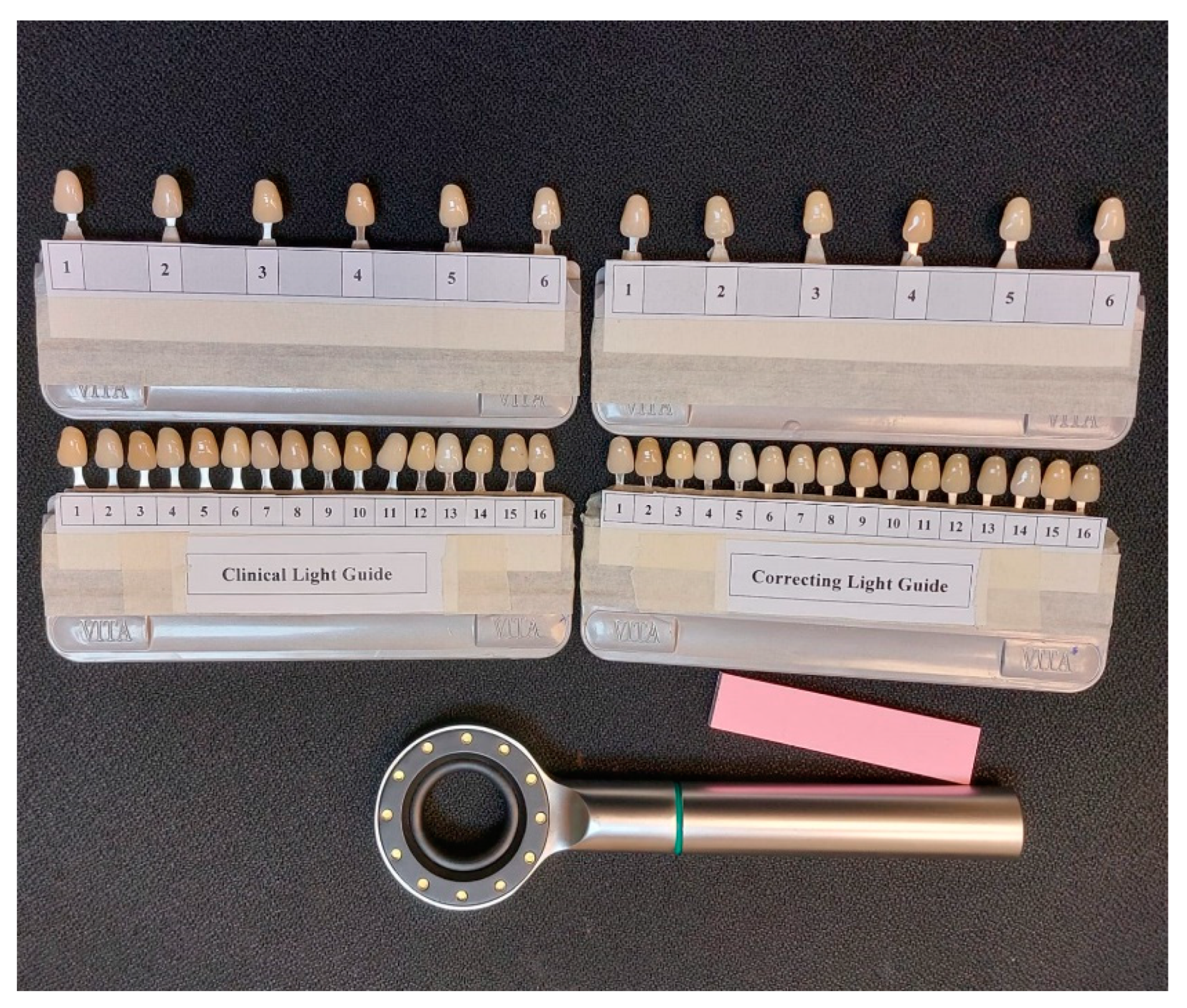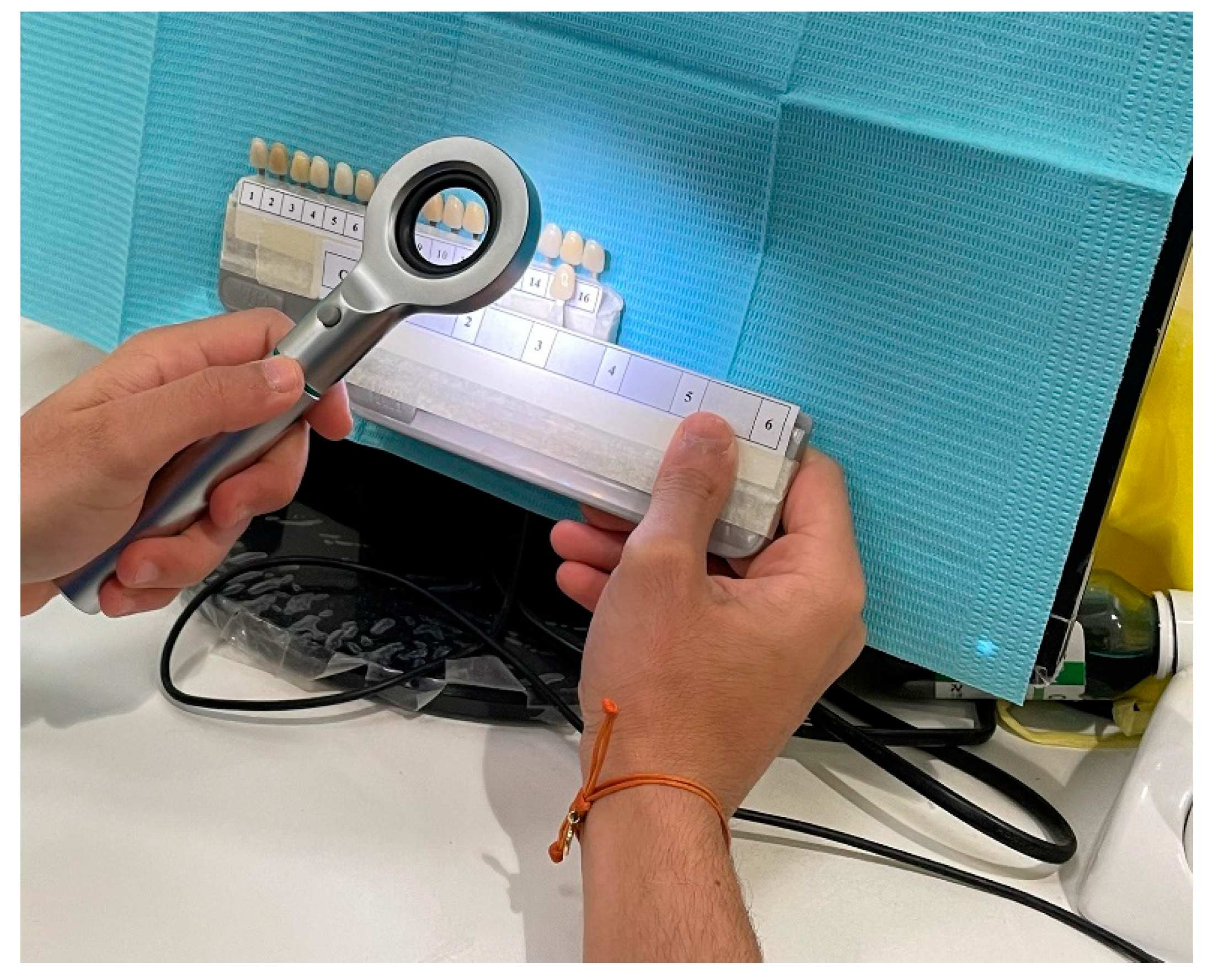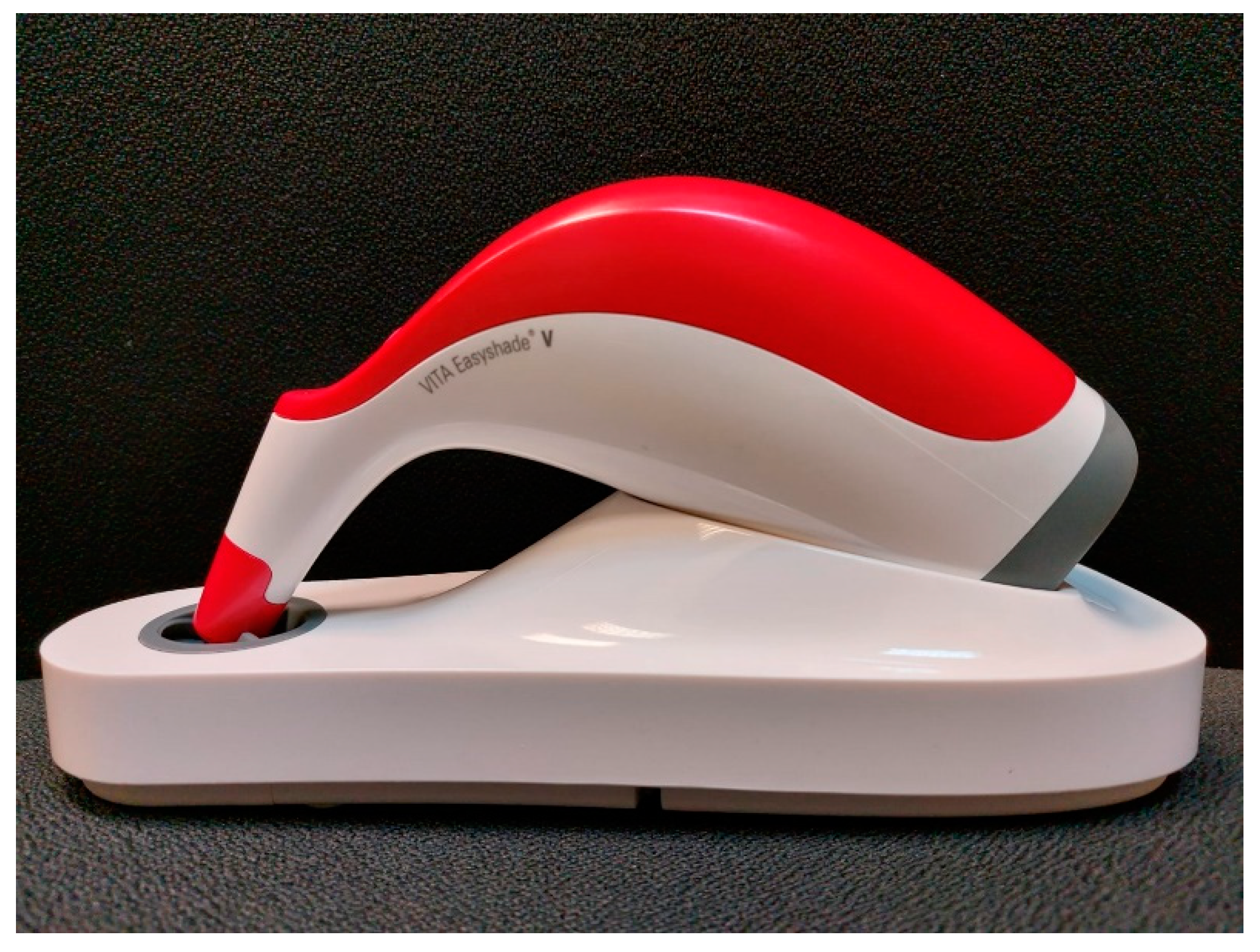Comparison of Shade Matching Ability among Dental Students under Different Lighting Conditions: A Cross-Sectional Study
Abstract
:1. Introduction
2. Materials and Methods
2.1. Shade Guide Preparation
2.2. Shade Matching Conditions
2.3. Statistical Analysis
3. Results
4. Discussion
5. Conclusions
Funding
Institutional Review Board Statement
Informed Consent Statement
Data Availability Statement
Acknowledgments
Conflicts of Interest
References
- Okuda, W.H. Minimally invasive dentistry and its impact on esthetic restorative dentistry. Gen. Dent. 2013, 61, 24–26. [Google Scholar] [PubMed]
- Jouhar, R.; Ahmed, M.A.; Khurshid, Z. An Overview of Shade Selection in Clinical Dentistry. Appl. Sci. 2022, 12, 6841. [Google Scholar] [CrossRef]
- Reno, E.A.; Sunberg, R.J.; Block, R.P.; Bush, R.D. The influence of lip/gum color on subject perception of tooth color. J. Dent. Res. 2000, 79, 381. [Google Scholar]
- Oguro, R.; Nakajima, M.; Seki, N.; Sadr, A.; Tagami, J.; Sumi, Y. The role of enamel thickness and refractive index on human tooth color. J. Dent. 2016, 15, 36–44. [Google Scholar] [CrossRef] [PubMed]
- Corcodel, N.; Helling, S.; Rammelsberg, P.; Hassel, A.J. Metameric effect between natural teeth and the shade tabs of a shade guide. Eur. J. Oral. Sci. 2010, 118, 311–316. [Google Scholar] [CrossRef] [PubMed]
- Chu, S.J.; Trushkowsky, R.D.; Paravina, R.D. Dental color matching instruments and systems. Review of clinical and research aspects. J. Dent. 2010, 38, 2–16. [Google Scholar] [CrossRef]
- Igiel, C.; Lehmann, K.M.; Ghinea, R.; Weyhrauch, M.; Hangx, Y.; Scheller, H.; Paravina, R.D. Reliability of visual and instrumental color matching. J. Esthet. Restor. Dent. 2017, 29, 303–308. [Google Scholar] [CrossRef] [PubMed]
- Yuan, J.C.; Brewer, J.D.; Monaco, E.A.; Davis, E.L., Jr. Defining a natural tooth color space based on a 3-dimensional shade system. J. Prosthet. Dent. 2007, 98, 110–119. [Google Scholar] [CrossRef]
- Hardan, L.; Bourgi, R.; Cuevas-Suárez, C.E.; Lukomska-Szymanska, M.; Monjarás-Ávila, A.J.; Zarow, M.; Jakubowicz, N.; Jorquera, G.; Ashi, T.; Mancino, D.; et al. Novel Trends in Dental Color Match Using Different Shade Selection Methods: A Systematic Review and Meta-Analysis. Materials 2022, 15, 468. [Google Scholar] [CrossRef]
- Alomari, M.; Chadwick, R.G. Factors influencing the shade matching performance of dentists and dental technicians when using two different shade guides. Br. Dent. J. 2011, 211, 23. [Google Scholar] [CrossRef] [PubMed]
- Preethi Suganya, S.; Manimaran, P.; Saisadan, D.; Dhinesh Kumar, C.; Abirami, D.; Monnica, V. Evaluation of Shade Selection with Digital and Visual Methods. J. Pharm. Bioallied. Sci. 2020, 12, 319–323. [Google Scholar] [CrossRef]
- Tabatabaian, F.; Beyabanaki, E.; Alirezaei, P.; Epakchi, S. Visual and digital tooth shade selection methods, related effective factors and conditions, and their accuracy and precision: A literature review. J. Esthet. Restor. Dent. 2021, 33, 1084–1104. [Google Scholar] [CrossRef] [PubMed]
- Judeh, A.; Al-Wahadni, A. A comparison between conventional visual and spectrophotometric methods for shade selection. Quintessence Int. 2009, 40, e69–e79. [Google Scholar] [PubMed]
- Udiljak, Z.; Illeš, D.; Zlatarić, D.K.; Ćelić, R. Effect of Clinical Experience on the Shade Matching Accuracy in Different Dental Occupational Groups. Acta Stomatol. Croat. 2018, 52, 132–139. [Google Scholar] [CrossRef] [PubMed]
- Borse, S.; Chaware, S.H. Tooth shade analysis and selection in prosthodontics: A systematic review and meta-analysis. J. Indian Prosthodont. Soc. 2020, 20, 131–140. [Google Scholar] [PubMed]
- Gasparik, C.; Grecu, A.G.; Culic, B.; Badea, M.E.; Dudea, D. Shade-matching Performance Using a New Light-correcting Device. J. Esthet. Res. Dent. 2015, 27, 285–292. [Google Scholar] [CrossRef] [PubMed]
- Jasinevicius, T.R.; Curd, F.M.; Schilling, L.; Sadan, A. Shade-matching abilities of dental laboratory technicians using a commercial light source. J. Prosthodont. 2009, 18, 60–63. [Google Scholar] [CrossRef] [PubMed]
- McAndrew, R.; Chan, P.W.; Milward, P.J. An assessment of shade taking by dental undergraduates. Eur. J. Prosthodont. Restor. Dent. 2010, 18, 13–16. [Google Scholar]
- Corcodel, N.; Rammelsberg, P.; Moldovan, O.; Dreyhaupt, J.; Hassel, A.J. Effect of external light conditions during matching of tooth color: An intraindividual comparison. Int. J. Prosthodont. 2009, 22, 75–77. [Google Scholar] [PubMed]
- Nakhaei, M.; Ghanbarzadeh, J.; Keyvanloo, S.; Alavi, S.; Jafarzadeh, H. Shade matching performance of dental students with three various lighting conditions. J. Contemp. Dent. Pract. 2013, 14, 100–103. [Google Scholar]
- Śmielecka, M.; Dorocka-Bobkowska, B. Effects of different light sources on tooth shade selection. Dent. Med. Probl. 2020, 57, 61–66. [Google Scholar] [CrossRef] [PubMed]
- Lee, Y.K.; Lim, B.S.; Kim, C.W. Difference in the colour and colour change of dental resin composites by the background. J. Oral Rehabil. 2005, 32, 227–233. [Google Scholar] [CrossRef]
- Milagres, V.; Teixeira, M.L.; Miranda, M.E.; Osorio Silva, C.H.; Ribeiro Pinto, J.R. Effect of gender, experience, and value on color perception. Oper. Dent. 2012, 37, 228–233. [Google Scholar]
- Dietschi, D.; Fahl, N., Jr. Shading concepts and layering techniques to master direct anterior composite restorations: An update. Br. Dent. J. 2016, 221, 765–771. [Google Scholar] [CrossRef] [PubMed]
- Color Vision Testing. Colorblind Home Page. Available online: http://colorvisiontesting.com/ishihara.htm (accessed on 1 July 2014).
- Curd, F.M.; Jasinevicius, T.R.; Graves, A.; Cox, V.; Sadan, A. Comparison of the shade matching ability of dental students using two light sources. J. Prosthet. Dent. 2006, 96, 391–396. [Google Scholar] [CrossRef] [PubMed]
- Rayyan, M.M. Comparison of Hand-Held Full Spectrum Light and Two Different Lighting Conditions on Accuracy of Visual Tooth Shade Matching. Egypt. Dent. J. 2014, 60, 2525–2531. [Google Scholar]
- Mete, J.J.; Dange, S.P.; Khalikar, A.N.; Vaidya, S.P. Comparative study of shade matching performance of dental students under natural daylight and daylight lamp conditions. Eur. J. Esthet. Dent. 2013, 8, 192–199. [Google Scholar] [PubMed]
- Posavec, I.; Prpić, V.; Zlatarić, D.K. Influence of Light Conditions and Light Sources on Clinical Measurement of Natural Teeth Color using VITA Easyshade Advance 4,0® Spectrophotometer. Pilot Study. Acta Stomatol. Croat. 2016, 50, 337–347. [Google Scholar] [CrossRef]
- Dagg, H.; O’Connell, B.; Claffey, N.; Byrne, D.; Gorman, C. The influence of some different factors on the accuracy of shade selection. J. Oral Rehabil. 2004, 31, 900–904. [Google Scholar] [CrossRef]
- Hassel, A.J.; Koke, U.; Schmitter, M.; Beck, J.; Rammelsberg, P. Clinical effect of different shade guide systems on the tooth shades of ceramic-veneered restorations. Int. J. Prosthodont. 2005, 18, 422–426. [Google Scholar] [CrossRef]
- Gokce, H.S.; Piskin, B.; Ceyhan, D.; Gokce, S.M.; Arisan, V. Shade Matching Performance of Normal and Color Vision-Deficient Dental Professionals with Standard Daylight and Tungsten Illuminants. J. Prosthet. Dent. 2010, 103, 139–147. [Google Scholar] [CrossRef]
- Paramei, G.V.; Bimler, D.L.; Cavonius, C.R. Effect of luminance on color perception of protanopes. Vis. Res. 1998, 38, 3397–3401. [Google Scholar] [CrossRef]
- Hammad, I.A. Intrarater repeatability of shade selections with two shade guides. J. Prosthet. Dent. 2003, 89, 50–53. [Google Scholar] [CrossRef]
- Haddad, H.J.; Jakstat, H.A.; Arnetzl, G.; Borbely, J.; Vichi, A.; Dumfahrt, H.; Renault, P.; Corcodel, N.; Pohlen, B.; Marada, G.; et al. Does gender and experience influence shade matching quality? J. Dent. 2009, 37, 40–44. [Google Scholar] [CrossRef] [PubMed]
- Winkler, S.; Boberick, K.G.; Weitz, K.S.; Datikashvili, I.; Wood, R. Shade matching by dental students. J. Oral Implantol. 2006, 32, 256–258. [Google Scholar] [CrossRef]
- Clary, J.A.; Ontiveros, J.C.; Cron, S.G.; Paravina, R.D. Influence of Light Source, Polarization, Education, and Training on Shade Matching Quality. J. Prosthet. Dent. 2016, 116, 91–97. [Google Scholar] [CrossRef] [PubMed]
- Jain, M.; Jain, V.; Yadav, N.R.; Jain, S.; Singh, S.; Raghav, P.; Kohli, J.; Sharma, A. Dental students’ tooth shade selection ability in relation to years of dental education. J. Fam. Med. Prim. Care 2019, 8, 4010–4014. [Google Scholar]
- Paravina, R.D.; Majkic, G.; Imai, F.H.; Powers, J.M. Optimization of tooth color and shade guide design. J. Prosthodont. 2007, 16, 269–276. [Google Scholar] [CrossRef]
- Joiner, A. Tooth colour: A review of the literature. J. Dent. 2004, 32, 3–12. [Google Scholar] [CrossRef]
- Culpepper, W.D. A comparative study of shade-matching procedures. J. Prosthet. Dent. 1970, 24, 166–173. [Google Scholar] [CrossRef]
- Alkhudairy, R.; Tashkandi, E. The Effectiveness of a Shade-Matching Training Program on the Dentists’ Ability to Match Teeth Color. J. Esthet. Restor. Dent. 2017, 29, E33–E43. [Google Scholar] [CrossRef] [PubMed]
- Naik, V.A.; Pai, R.C. Colour blindness in dental students and staff—An obstacle in shade selection for restorations. Ann. essences dent. 2010, 2, 25–28. [Google Scholar]
- Increased Predictability in Tooth Shade-Matching. Available online: https://www.oralhealthgroup.com/features/increased-predictability-in-tooth-shade-matching-kelvin-i-afrashtehfar-dds-msc-c/ (accessed on 15 September 2022).
- Borbély, J.; Varsányi, B.; Fejérdy, P.; Hermann, P.; Jakstat, H.A. Tooth guide Trainer tests with color vision deficiency simulation monitor. J. Dent. 2010, 38, e41–e49. [Google Scholar] [CrossRef] [PubMed]




| Age | Mean (Years) | SD (Years) | |
|---|---|---|---|
| 21.66 | 1.397 | ||
| Academic Year | Frequency (n = 102) | Percentage (%) | |
| Non-Clinical Students (n = 41) | 2nd Year | 19 | 18.6% |
| 3rd Year | 22 | 21.6% | |
| Clinical Students (n = 61) | 4th Year | 21 | 20.6% |
| 5th Year | 19 | 18.6% | |
| 6th Year | 21 | 20.6% |
| D3 | C2 | B3 | A4 | B2 | A2 | ||
|---|---|---|---|---|---|---|---|
| % (no.) | % (no.) | % (no.) | % (no.) | % (no.) | % (no.) | ||
| Non Clinical Students (n = 41) | Clinical Light | 21.95 (9) | 9.75 (4) | 17.07 (7) | 21.95 (9) | 21.95 (5) | 17.07 (7) |
| Correcting Light | 43.90 (18) | 24.39 (10) | 39.02 (16) | 41.46 (17) | 36.58 (15) | 43.90 (18) | |
| p-value | 0.034 | 0.078 | 0.027 | 0.058 | 0.010 | 0.008 | |
| Clinical Students (n = 61) | Clinical Light | 44.26 (27) | 37.70 (23) | 39.34 (24) | 32.78 (20) | 52.45 (32) | 37.70 (23) |
| Correcting Light | 75.40 (46) | 59.01 (36) | 72.13 (44) | 63.93 (39) | 65.57 (40) | 70.49 (43) | |
| p-value | <0.001 | 0.019 | 0.000 | 0.001 | 0.141 | <0.001 |
| D3 | C2 | B3 | A4 | B2 | A2 | ||
|---|---|---|---|---|---|---|---|
| % (no.) | % (no.) | % (no.) | % (no.) | % (no.) | % (no.) | ||
| Clinical Light | Non Clinical Students (n = 41) | 21.95 (9) | 9.75 (4) | 17.07 (7) | 21.95 (9) | 21.95 (5) | 17.07 (7) |
| Clinical Students (n = 61) | 44.26 (27) | 37.70 (23) | 39.34 (24) | 32.78 (20) | 52.45 (32) | 37.70 (23) | |
| p-value | 0.021 | 0.002 | 0.016 | 0.234 | <0.001 | 0.025 | |
| Correcting Light | Non Clinical Students (n = 41) | 43.90 (18) | 24.39 (10) | 39.02 (16) | 41.46 (17) | 36.58 (15) | 43.90 (18) |
| Clinical Students (n = 61) | 75.40 (46) | 59.01 (36) | 72.13 (44) | 63.93 (39) | 65.57 (40) | 70.49 (43) | |
| p-value | 0.001 | 0.001 | 0.001 | 0.025 | 0.004 | 0.007 |
| Non-Clinical Students | ||
|---|---|---|
| Mean ± SD | p-Value | |
| Clinical light | 1 ± 1.11 | <0.001 |
| Correcting Light | 2.29 ± 1.26 | |
| Clinical Students | ||
| Mean ± SD | p-Value | |
| Clinical light | 2.47 ± 1.25 | <0.001 |
| Correcting Light | 4.01 ± 1.34 | |
Publisher’s Note: MDPI stays neutral with regard to jurisdictional claims in published maps and institutional affiliations. |
© 2022 by the author. Licensee MDPI, Basel, Switzerland. This article is an open access article distributed under the terms and conditions of the Creative Commons Attribution (CC BY) license (https://creativecommons.org/licenses/by/4.0/).
Share and Cite
Jouhar, R. Comparison of Shade Matching Ability among Dental Students under Different Lighting Conditions: A Cross-Sectional Study. Int. J. Environ. Res. Public Health 2022, 19, 11892. https://doi.org/10.3390/ijerph191911892
Jouhar R. Comparison of Shade Matching Ability among Dental Students under Different Lighting Conditions: A Cross-Sectional Study. International Journal of Environmental Research and Public Health. 2022; 19(19):11892. https://doi.org/10.3390/ijerph191911892
Chicago/Turabian StyleJouhar, Rizwan. 2022. "Comparison of Shade Matching Ability among Dental Students under Different Lighting Conditions: A Cross-Sectional Study" International Journal of Environmental Research and Public Health 19, no. 19: 11892. https://doi.org/10.3390/ijerph191911892
APA StyleJouhar, R. (2022). Comparison of Shade Matching Ability among Dental Students under Different Lighting Conditions: A Cross-Sectional Study. International Journal of Environmental Research and Public Health, 19(19), 11892. https://doi.org/10.3390/ijerph191911892








